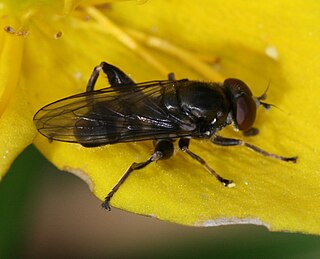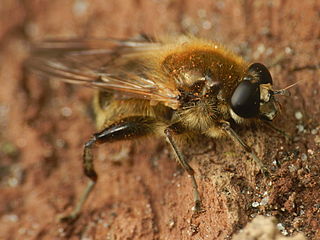
Hover flies, also called flower flies or syrphid flies, make up the insect family Syrphidae. As their common name suggests, they are often seen hovering or nectaring at flowers; the adults of many species feed mainly on nectar and pollen, while the larvae (maggots) eat a wide range of foods. In some species, the larvae are saprotrophs, eating decaying plant and animal matter in the soil or in ponds and streams. In other species, the larvae are insectivores and prey on aphids, thrips, and other plant-sucking insects.

Temnostoma is a genus of hoverflies. The larvae of some species feed on the wood of deciduous trees.

Temnostoma bombylans is a species of hoverfly. Larva of this species feed in decaying wood of deciduous trees.

Chalcosyrphus (Xylotomima) nemorum , the Dusky-banded Leafwalker, is a common species of syrphid fly with a Palearctic and Nearctic distribution. Hoverflies get their names from the ability to remain nearly motionless while in flight. The adults are also known as flower flies for they are commonly found around and on flowers, from which they get both energy-giving nectar and protein-rich pollen. Larvae have been found under the bark of Larix, Pinus and a variety of hardwoods.

Brachypalpus is a genus of hoverflies, from the family Syrphidae, in the order Diptera. The head is triangular and produced well forwards and somewhat downwards. The thorax and abdomen with pile often rather long. The hind femur is swollen and with an obtuse spur apically and ventrally. The hind trochanters of male is spurred.
The larvae are of the rat-tailed type feeding on decaying sap under tree bark. Larvae live in decaying trees and logs. Larva and pupa have been described by Malloch.

Callicera erratica , the Golden Pine Fly , is a rare species of syrphid fly observed in the Northeastern United States and Canada. Hoverflies can remain nearly motionless in flight. The adults are also known as flower flies for they are commonly found on flowers from which they get both energy-giving nectar and protein-rich pollen. Larvae live in water filled rotholes and cavities of old living conifers.
Criorhina verbosa, the Hairy-cheeked Bumble Fly, is an uncommon species of syrphid fly observed in the eastern to central northeastern United States. Hoverflies can remain nearly motionless in flight. The adults are also known as flower flies for they are commonly found on flowers, from which they get both energy-giving nectar and protein-rich pollen. The larvae of this genus are found in decaying wood.

Temnostoma venustum , the Black-banded Falsehorn , is a rare species of syrphid fly observed in the northeastern United States and adjacent Canada. Hoverflies can remain nearly motionless in flight. The adults are also known as flower flies for they are commonly found on flowers, from which they get both energy-giving nectar and protein rich pollen. Temnostoma adults are strong wasp mimics The larvae burrow in moist decayed wood.

Temnostoma alternans , the Wasp-like falsehorn, is a common species of syrphid fly observed throughout the northern and central United States and widespread in Canada. Hoverflies can remain nearly motionless in flight. The adults are also known as flower flies for they are commonly found on flowers, from which they get both energy-giving nectar and protein-rich pollen. Larvae burrow in moist decayed wood.

Spilomyia alcimus, the Broad-banded Hornet Fly, is an uncommon species of syrphid fly first officially described by Walker in 1849. Hoverflies get their names from the ability to remain nearly motionless while in flight. The adults are also known as flower flies for they are commonly found around and on flowers, from which they get both energy-giving nectar and protein-rich pollen. The larvae are known as the short-tailed larvae suited for moist areas such as rot holes of trees.

Temnostoma balyras , the Yellow-haired Falsehorn , is a common species of syrphid fly observed in the eastern half of the United States and adjacent areas of Canada. Hoverflies can remain nearly motionless in flight. The adults are also known as flower flies for they are commonly found on flowers, from which they get both energy-giving nectar and protein-rich pollen. Larvae burrow in moist decayed wood using their hooks as rasping organs operated in a forwards and backwards motion by huge muscles housed in the mesothorax and metathorax. The larvae of T.balyras have been described by Heiss in "A classification of the larvae and puparia of the Syrphidae of Illinois exclusive of aquatic forms".

Spilomyia liturata, the Rocky Mountain Hornet Fly, is an uncommon species of syrphid fly. This species is found in western North America along the Rocky Mountains. Hoverflies get their names from the ability to remain nearly motionless while in flight. The adults are also known as flower flies for they are commonly found around and on flowers, from which they get both energy-giving nectar and protein-rich pollen. The larvae are known as the short-tailed larvae, suited for moist areas such as rot holes of trees.

Temnostoma barberi , the Bare-bellied Falsehorn, is a fairly common species of syrphid fly observed in the eastern half of the United States and adjacent areas of Canada. Hoverflies can remain nearly motionless in flight. The adults are also known as flower flies for they are commonly found on flowers, from which they get both energy-giving nectar and protein-rich pollen. Temnostoma adults are strong wasp mimics. The larvae burrow in moist decayed wood.

Temnostoma trifasciatum, the Three-lined Falsehorn, is a rare species of syrphid fly observed in the eastern and central parts of the United States. Hoverflies can remain nearly motionless in flight. The adults are also known as flower flies for they are commonly found on flowers, from which they get both energy-giving nectar and protein-rich pollen. Temnostoma adults are strong wasp mimics. Larvae burrow in moist decayed wood.

Chalcosyrphus (Xylotomima) piger, the short-haired leafwalker, is an uncommon species of syrphid fly found throughout North America and Europe. Hoverflies get their names from the ability to remain nearly motionless while in flight. The adults are also known as flower flies, for they are commonly found around and on flowers, from which they get both energy-giving nectar and protein-rich pollen. Larvae have been identified from sappy hollows from Larix and Pinus.

Temnostoma excentrica , the Black-spotted Falsehorn , is a common species of syrphid fly observed throughout the United States and Canada. Hoverflies can remain nearly motionless in flight. The adults are also known as flower flies for they are commonly found on flowers, from which they get both energy-giving nectar and protein-rich pollen. Temnostoma adults are strong wasp mimics. The larvae burrow in moist decayed wood.
Neoascia globosa , the Black-margined Fen , is a fairly common species of syrphid fly observed in northeastern North America. Hoverflies can remain nearly motionless in flight. The adults are also known as flower flies, for they are commonly found on flowers from which they get both energy-giving nectar and protein-rich pollen. The larvae are aquatic.
Parhelophilus porcus , the black bog fly, is an uncommon species of syrphid fly observed in Northern North America. Hoverflies can remain nearly motionless in flight. The adults are also known as flower flies for they are commonly found on flowers from which they get both energy-giving nectar and protein-rich pollen. The larvae are the long tailed "rat-tailed" type.
Trichopsomyia apisaon, the black-haired psyllid-killer, is a common species of syrphid fly observed all across North America. Hoverflies can remain nearly motionless in flight. The adults are also known as flower flies for they are commonly found on flowers from which they get both energy-giving nectar and protein-rich pollen. Larvae when known are psyllid, aphid and Phylloxera predators.
Total of 245 species either found or highly expected to be found in New York.















